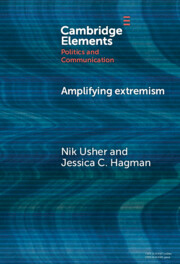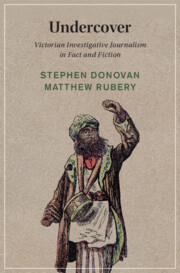Refine search
Actions for selected content:
140 results
9 - The Role of the Private Sector in Countering Terrorist Financing and the Importance of Public–Private Partnerships
-
- Book:
- Terror Disrupted
- Published online:
- 18 December 2025
- Print publication:
- 22 January 2026, pp 167-187
-
- Chapter
- Export citation
Stereotypes as mnemonic frames: How journalism mediates collective memory in representations of foreign groups
- Part of
-
- Journal:
- Memory, Mind & Media / Volume 4 / 2025
- Published online by Cambridge University Press:
- 25 November 2025, e25
-
- Article
-
- You have access
- Open access
- HTML
- Export citation
Chapter 5 - On Being Right
-
- Book:
- Zola's Dream
- Published online:
- 07 August 2025
- Print publication:
- 21 August 2025, pp 210-251
-
- Chapter
- Export citation
19 - Reconstructing the First Amendment
- from Part V - Identifying Performers of the Press Function
-
-
- Book:
- The Future of Press Freedom
- Published online:
- 25 July 2025
- Print publication:
- 24 July 2025, pp 309-324
-
- Chapter
-
- You have access
- Open access
- HTML
- Export citation
8 - Defamation Law and the Crumbling Legitimacy of the Fourth Estate
- from Part III - Evolving Threats to the Press Function
-
-
- Book:
- The Future of Press Freedom
- Published online:
- 25 July 2025
- Print publication:
- 24 July 2025, pp 100-115
-
- Chapter
-
- You have access
- Open access
- HTML
- Export citation
24 - Legal Foundations for Non-reformist Media Reforms
- from Part VI - Supporting the Press Function
-
-
- Book:
- The Future of Press Freedom
- Published online:
- 25 July 2025
- Print publication:
- 24 July 2025, pp 415-436
-
- Chapter
-
- You have access
- Open access
- HTML
- Export citation
18 - A Professional Wrestler, Privacy, and the Meaning of News
- from Part V - Identifying Performers of the Press Function
-
-
- Book:
- The Future of Press Freedom
- Published online:
- 25 July 2025
- Print publication:
- 24 July 2025, pp 298-308
-
- Chapter
-
- You have access
- Open access
- HTML
- Export citation
7 - Countering the Mosaic of Threats to Press Functions
- from Part III - Evolving Threats to the Press Function
-
-
- Book:
- The Future of Press Freedom
- Published online:
- 25 July 2025
- Print publication:
- 24 July 2025, pp 79-99
-
- Chapter
-
- You have access
- Open access
- HTML
- Export citation
14 - The Long Shadow of Food Lion
- from Part IV - Legal Protection for the Press Function
-
-
- Book:
- The Future of Press Freedom
- Published online:
- 25 July 2025
- Print publication:
- 24 July 2025, pp 210-246
-
- Chapter
-
- You have access
- Open access
- HTML
- Export citation
6 - Fitting a Square Peg into a Round Hole
- from Part III - Evolving Threats to the Press Function
-
-
- Book:
- The Future of Press Freedom
- Published online:
- 25 July 2025
- Print publication:
- 24 July 2025, pp 67-78
-
- Chapter
-
- You have access
- Open access
- HTML
- Export citation
17 - From Bloggers in Pajamas to the Gateway Pundit
- from Part V - Identifying Performers of the Press Function
-
-
- Book:
- The Future of Press Freedom
- Published online:
- 25 July 2025
- Print publication:
- 24 July 2025, pp 271-297
-
- Chapter
-
- You have access
- Open access
- HTML
- Export citation
Chapter 34 - Poetry, Short Stories, Journalism, and Non-Fiction
- from Part V - Non-Theatrical Writings
-
-
- Book:
- Sean O'Casey in Context
- Published online:
- 23 June 2025
- Print publication:
- 10 July 2025, pp 372-380
-
- Chapter
- Export citation
How to Do Public Writing
- Part of
-
- Journal:
- Public Humanities / Volume 1 / 2025
- Published online by Cambridge University Press:
- 02 June 2025, e100
-
- Article
-
- You have access
- Open access
- HTML
- Export citation

Amplifying Extremism
- Small Town Politicians, Media Storms, and American Journalism
-
- Published online:
- 19 May 2025
- Print publication:
- 12 June 2025
-
- Element
- Export citation
Chapter 4 - Anthropologies of the Mechanical Arts
-
- Book:
- Satire, Instruction and Useful Knowledge in Eighteenth-Century Britain
- Published online:
- 24 April 2025
- Print publication:
- 08 May 2025, pp 84-108
-
- Chapter
-
- You have access
- Open access
- Export citation
8 - Getting Truth into the Media
-
- Book:
- A Climate of Truth
- Published online:
- 27 March 2025
- Print publication:
- 27 March 2025, pp 174-192
-
- Chapter
- Export citation
Pacific Islanders Experience the Pacific War: Informants as Historians and Story Tellers
-
- Journal:
- Asia-Pacific Journal / Volume 15 / Issue 20 / October 2017
- Published online by Cambridge University Press:
- 14 March 2025, e1
-
- Article
-
- You have access
- Open access
- Export citation

Undercover
- Victorian Investigative Journalism in Fact and Fiction
-
- Published online:
- 13 March 2025
- Print publication:
- 20 March 2025
Should Science Journalists Know Science?
-
- Journal:
- Canadian Journal of Philosophy / Volume 54 / Issue 4 / May 2024
- Published online by Cambridge University Press:
- 26 February 2025, pp. 281-299
-
- Article
-
- You have access
- Open access
- HTML
- Export citation
Chapter 1 - Life and Times
-
- Book:
- The Cambridge Introduction to Samuel Johnson
- Published online:
- 07 February 2025
- Print publication:
- 13 February 2025, pp 1-22
-
- Chapter
- Export citation
